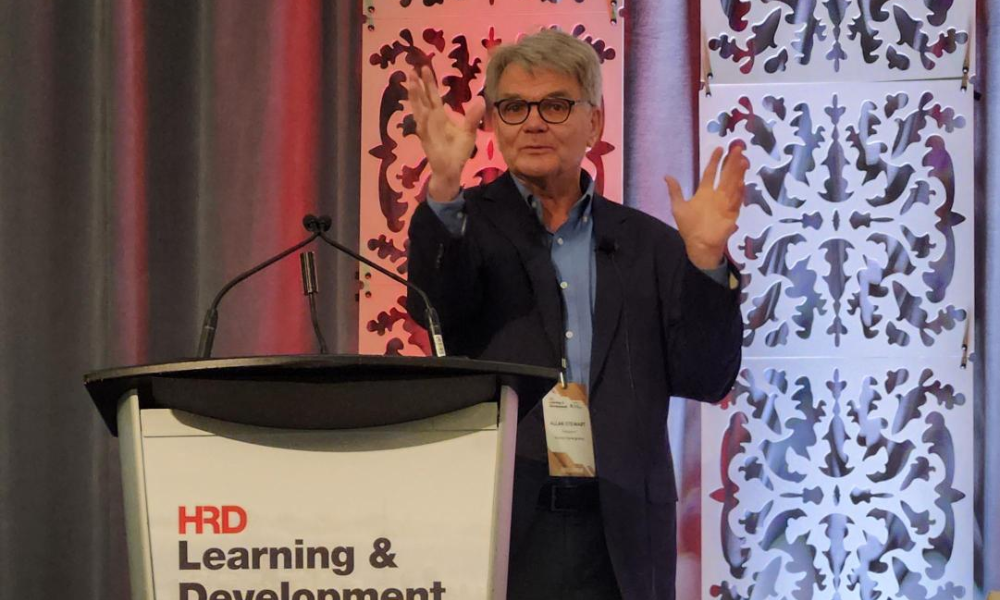
HRD's Learning & Development Summit features panels, discussions, case studies

Organizations are straying from training and developing their leaders, and instead are “crossing their fingers” and hoping that managers will simply manage on their own, according to one expert.
“If it comes to HR that a manager may not be the right fit, the reaction is often ‘Let’s terminate them and give them a big award package to keep everyone happy,’” said Allan Stewart, president of Human Synergistics.
“If we went back to basics, we would say, ‘Let’s send him to a couple of training courses – perhaps an internal one and an external one – train him and give him the tools to turn this around, and if he doesn’t, then it’s on him,’” he said.
Steward emphasized this point, alongside the importance of investing in training and developing leaders, at HRD’s Learning & Development Summit on April 10 in Toronto.
The summit featured panels, discussions and case studies on topics ranging from AI in learning and development to creating a personalized culture of ongoing learning.
Stewart spoke to HR professionals during his keynote session ‘Setting a new standard for L&D development.’ He emphasized the importance of investing in learning and development, highlighting the “phenomenon” in which employees are often promoted to a manager position for excelling in their role but not actually trained on how to be a leader.
“I am personally saddened by changes in HR management; there used to be hundreds of training and development managers across the country, who have been replaced now that technology has advanced,” he said.
He also stressed the “direct link” between culture, the organization and leadership and development, in which problems with leadership can lead to poor culture, which can ultimately lead to poor employee engagement, retention and the viability of the organization as a whole.
“Leadership is a major causal factor of culture, so if you’ve got a negative culture, you can guess that there’s probably a problem with leadership,” Stewart said.
To combat this, Stewart recommended that organizations measure their culture, making sure that the survey is valid, and use that measurement to invest in learning and development strategies that can benefit managers and employees alike.
The summit also featured a panel on integrating career planning, coaching and mentoring to guide L&D initiatives, which focused on aligning development strategies with business goals and making the most of resources and budgets dedicated to supporting coaching and mentoring.
Alan Kearns, managing partner and founder of CareerJoy, highlighted the need for a thoughtful approach to L&D strategies, particularly when it comes to coaching and mentoring.
“The whole issue we're talking is, essentially, how do we help teams be better at what they do? Not necessarily to do more with less time, but to do more with the realities of their circumstances,” Kearns said. “It's not about training; it's actually more about coaching and mentoring and getting the right people doing the right things in the right way, playing to their strengths and helping them to grow.”
He also discussed the business case for investing in coaching and mentoring and understanding that having a good framework that is customizable and flexible can be key for businesses to invest in their people and themselves.
Closing off the event with a look at what’s next for L&D in 2024 and beyond, Stephanie Fischkohl, manager of operations at Queen’s University IRC, discussed L&D trends. She noted a “huge uptick” in reskilling within organizations to give employees the necessary skills to grow and progress.
Highlighting the skills-based focused the workforce is currently seeing, she emphasized the need for leaders to be authentic with their teams and listen to their needs. With a wide range of generations in the workforce at the moment, it is more important than ever to listen to all generations and ensure they have the tools they need to succeed.
“I think the biggest message for HR professionals is asking: ‘How can we be better leaders? How can we improve? How can we supply the resources to our teams? A recent report showed that seven out of 10 people are not happy and want to leave their jobs, and that, for me, is concerning.
“So, what can we do better today than we did yesterday to really give employees the resources they need to be successful in their positions so that they want them to stay with the company a long time, instead of having turnover?” Fischkohl said.